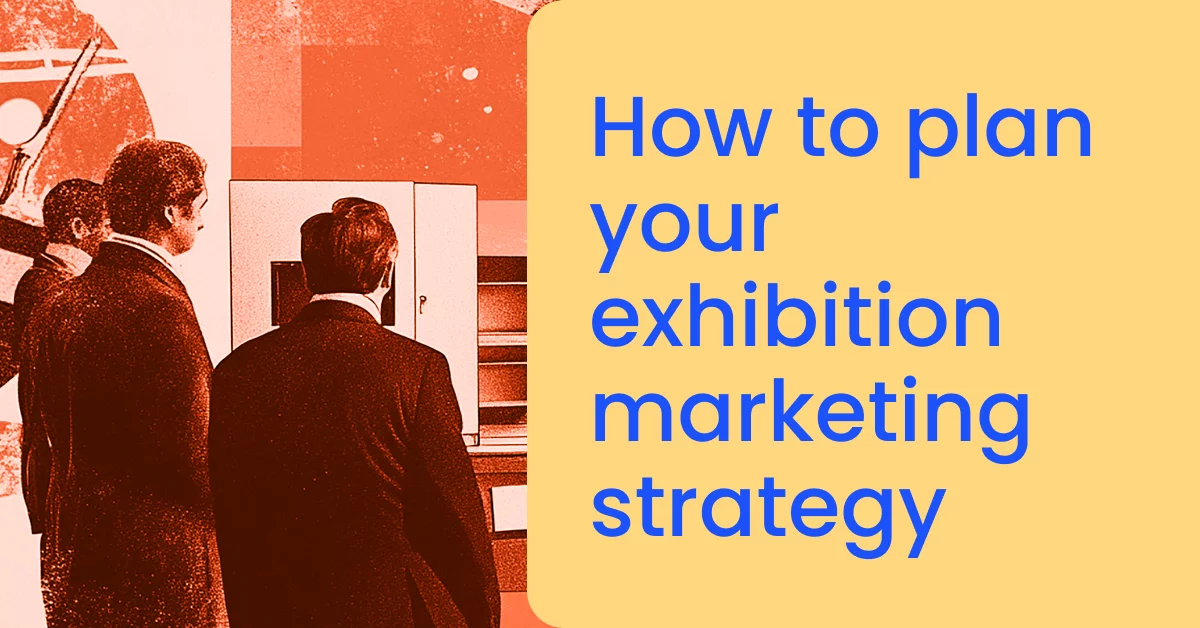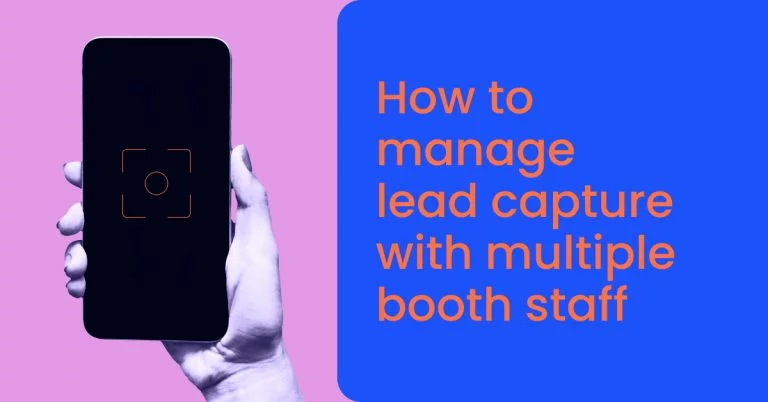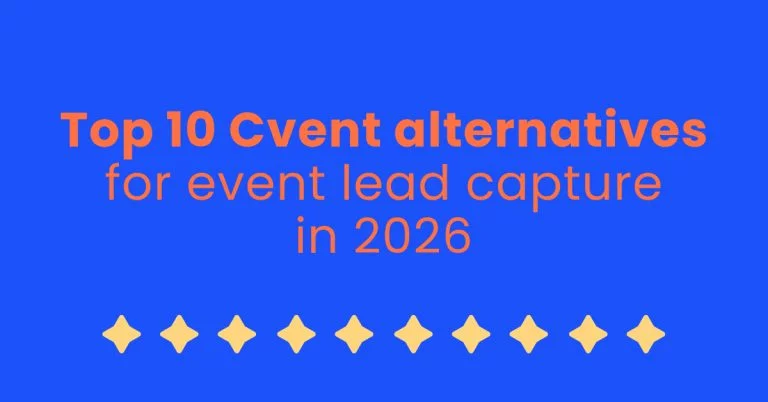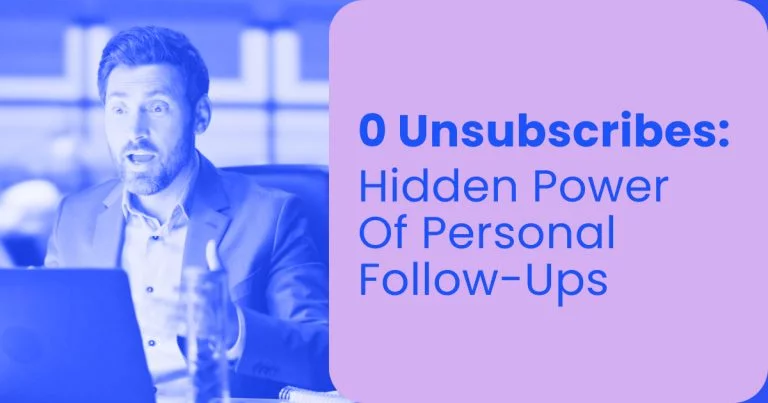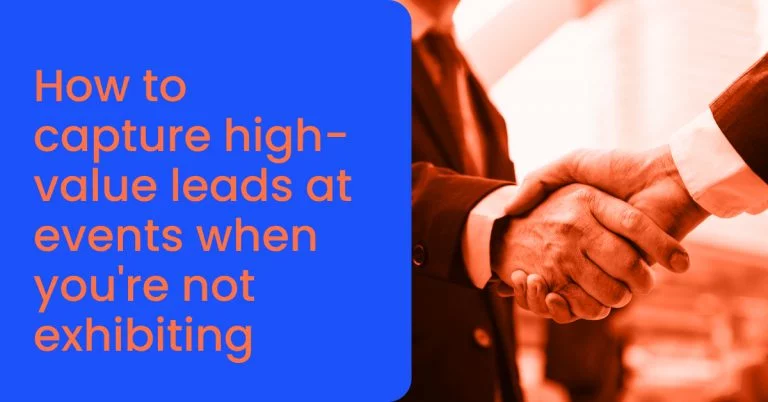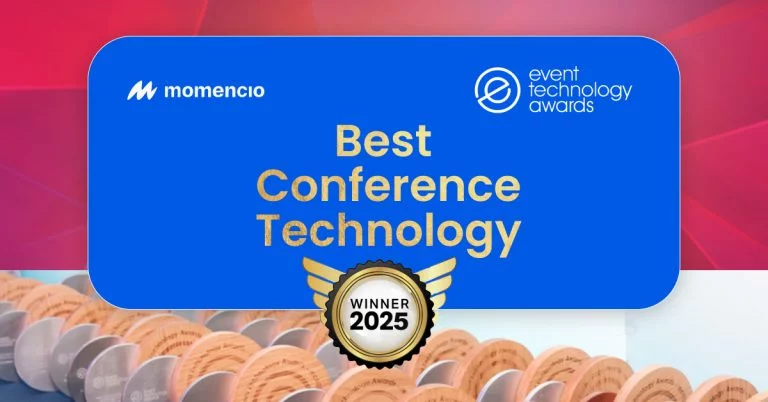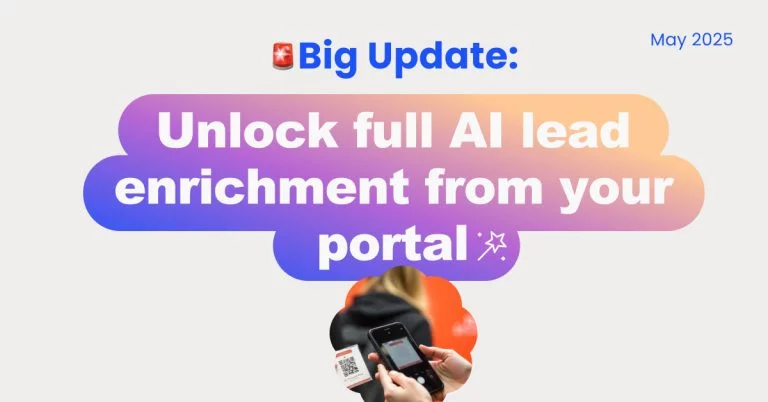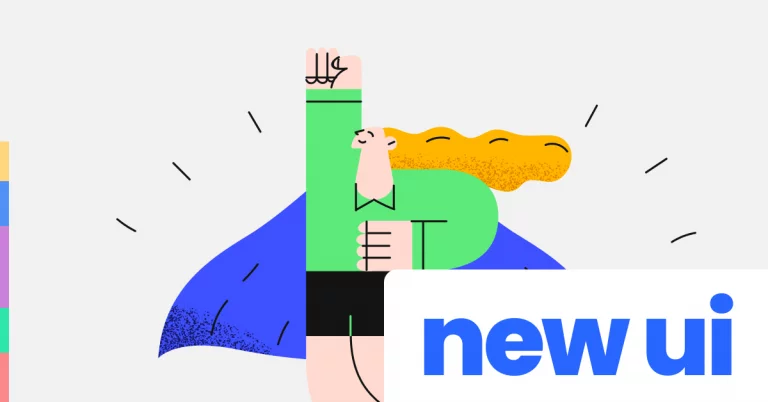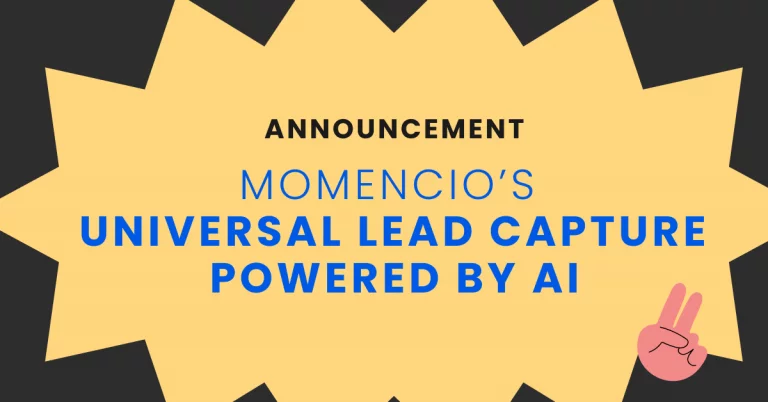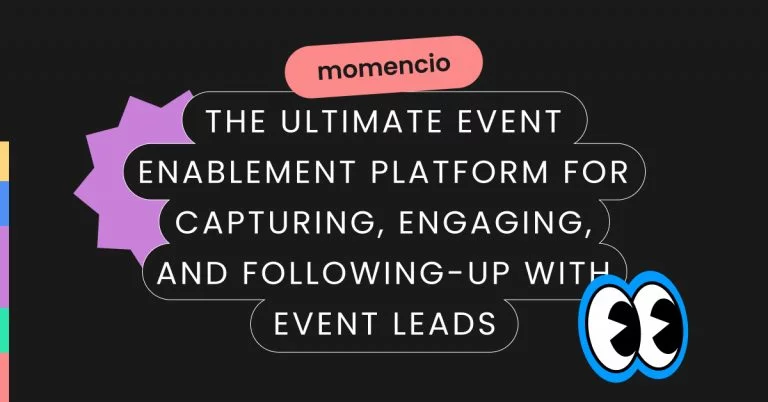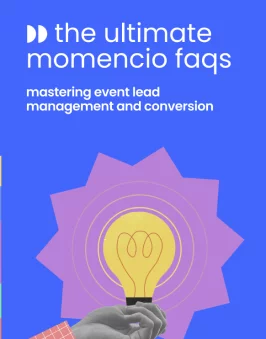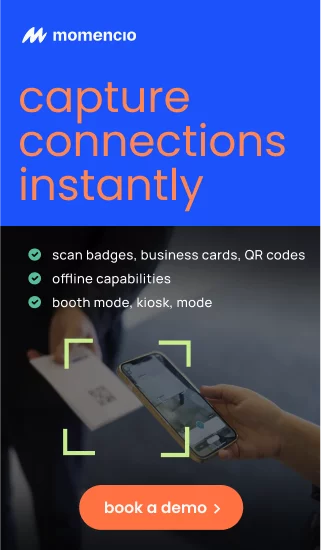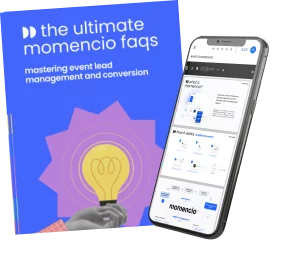Trade shows remain one of the last high-attention environments in B2B, but the stakes have never been higher. Exhibit space costs, service fees, and travel budgets are climbing at double-digit rates while buyers arrive with pre-baked shortlists and entire buying committees. Yet most exhibitors still measure success by a stack of badge scans that yields little usable context. Research from leading industry associations shows that while overall attendance has recovered, exhibitor ROI is flat or declining because post-show conversion lags.
This article lays out a data-driven approach to planning your exhibition marketing strategy that sidesteps these traps. You’ll see exactly how to capture first-party intent signals, engineer meaningful meetings, control hidden costs, and protect your follow-up — while using lead capture app like momencio to turn trade show activity into measurable pipeline and provable ROI.
Hooking the pain and framing the stakes
Exhibitors today face a paradox: trade show floors are full again, but the return on investment isn’t. Industry tracking reports show that exhibitor costs per square foot have risen more than 25% over the past six years, with the steepest increases hidden in drayage, electrical, and venue internet fees. At the same time, badge scanners provided by organizers still deliver incomplete or delayed data — often limited to name, title, and company, with no insight into intent, role in the buying process, or agreed-upon next step. Without that context, sales teams inherit cold records that decay within days.
The complexity of modern B2B buying amplifies the problem. Recent surveys indicate buying groups now average 8 to 13 stakeholders, and 86% of purchases stall or reset at least once. This means exhibitors who only collect surface-level contacts must do the heavy lift of re-qualifying leads after the show, losing the very time advantage that face-to-face events are supposed to provide.
Finance leaders are noticing. As budgets tighten, marketing and events teams are being asked to prove faster pipeline velocity from trade show spend or risk cuts in future participation. This pressure is why a growing number of exhibitors are looking beyond badge scanners to first-party capture systems that integrate with CRM in real time and trigger instant follow-up. Platforms like momencio are designed for this exact scenario — letting field teams build and send personalized microsites on the spot and track engagement back into the opportunity pipeline without manual work.
In other words, the problem isn’t just booth traffic — it’s a planning model built on outdated metrics and weak data capture. Next, we’ll look at why most exhibition marketing plans fail and how to avoid those pitfalls from the start.
Why most exhibition marketing plans fail
Instead of another wall of text, here’s a clear snapshot of where traditional plans break down and why exhibitors are losing ROI:
| Common practice | What’s actually happening now | Why it’s a problem |
| Collect badge scans only | Buying groups now average 8–13 stakeholders, and most scans capture just a name and company | Leads decay quickly because sales must re-qualify everyone after the show |
| Budget by booth space alone | Drayage, electrical labor, and venue internet have risen more than 25% since 2019, billed in unpredictable line items | Even a busy booth can lose its profit margin without a cost-control plan |
| Generic post-show email blast | Gmail/Yahoo now enforce SPF, DKIM, DMARC, one-click unsubscribe, and complaint thresholds; third-party cookies for retargeting are collapsing | Deliverability drops or campaigns are throttled, shrinking your post-show reach |
Traditional metrics like foot traffic and impressions no longer predict pipeline because the underlying data is shallow and fragmented. Without capturing intent and triggering automated engagement at the booth, exhibitors are left with expensive activity but little measurable impact.
Reframe success metrics from footfall to pipeline
Most exhibitors still report “number of leads collected” as their headline success metric. In today’s environment that number is almost meaningless. A stack of 1,000 badge scans with no context is not a pipeline; it’s a cold list. High-performing exhibitors are shifting to metrics that show movement toward revenue, not just movement through the booth.
Here’s what that shift looks like in practice:
- Qualified next steps created: Instead of counting raw contacts, measure how many visitors agreed to a defined action (scheduled a meeting, started a trial, requested a proposal) within 30 days of the show. Industry benchmarks show exhibitors using intent-based capture and instant follow-up produce up to 40% more “next steps” than those relying on rented scanners.
- Pipeline velocity: Track how quickly post-show opportunities progress compared to your non-event leads. When exhibitors tie booth data directly into CRM in real time, they see a measurable reduction in days-to-opportunity creation.
- Persona-level insights captured: With large buying groups, capturing the visitor’s role (technical evaluator, budget holder, user) at the booth allows you to route them into the right nurture flow immediately. This improves open and click rates in follow-up by double digits compared to a generic blast.
- Content engagement signals: Measure which assets were viewed, saved, or shared by visitors on the spot, so sales can prioritize the hottest prospects rather than chase all names equally.
A comprehensive event engagement platform like momencio makes this shift realistic because every interaction—badge scan, note, microsite click—is automatically stitched into one record and pushed to CRM with scoring already applied. This means exhibitors can adopt these metrics without building complex systems from scratch.
Pre-show strategy – engineer meetings, not just traffic
In 2025, the exhibitors getting disproportionate results aren’t the ones with the flashiest booths; they’re the ones who treat the show floor like a meeting factory. Instead of hoping passers-by stop, they pre-build their audience and agenda. Here’s a practical framework you can use:
1. Lock in qualified conversations before the doors open
Organizers now run hosted-buyer and AI-matchmaking programs that allow exhibitors to secure time with key prospects weeks in advance. Exhibitors who fill those slots typically report double-digit increases in pipeline versus relying on walk-ups. Make participation in these programs part of your plan, not an afterthought.
2. Segment and target your outreach
Use your CRM or marketing automation to identify accounts attending the show and send them personalized invitations for demos, roundtables, or private briefings. Include a clear value proposition (e.g., “exclusive preview,” “executive Q&A”) to drive opt-in. Exhibitors doing this see significantly higher show-up rates than generic “visit our booth” emails.
3. Pre-load content assets for instant delivery
Field marketers can pre-build digital kits—product sheets, pricing calculators, videos—mapped to different buyer personas. With momencio, these kits can be packaged into personalized microsites and sent instantly when an attendee engages, even before the event begins. Engagement on those microsites is tracked so reps know who’s most interested before they arrive at the booth.
4. Coordinate social and organizer channels
Many shows offer exhibitor spots in their official emails, apps, or LinkedIn groups. Use these channels to promote your pre-booked experiences rather than just your booth number. This creates a perception of scarcity and drives higher-quality traffic.
By approaching pre-show marketing this way, you arrive at the event with a calendar of qualified meetings instead of a hope for footfall.
Booth experience design – capture intent in real time
Even with strong pre-show outreach, the booth itself is where you either lock in real opportunities or collect a pile of cold contacts. The difference is in how you design the experience and the data capture. Here’s a high-impact way to structure your booth strategy:
Build first-party capture into the flow
Don’t rely on the organizer’s scanner. Set up your own capture points that ask for consent and collect buyer context (role, interest area, next step). Best lead capture tools like momencio do this natively — scanning a badge or QR code instantly creates a lead record enriched with your rep’s notes and the visitor’s selected interests.
Deliver something valuable on the spot
Replace generic brochures with digital assets that are sent instantly. With momencio, reps can build and send a personalized microsite from a mobile device in under a minute. Attendees get the content they want immediately, and you get first-party engagement data tied to that person.
Use interactive demos or self-guided content
Set up a tablet, touchscreen, or demo station where visitors can explore by persona (technical, budget, executive). Every click becomes an intent signal you can score later. Exhibitors using this approach report more qualified follow-ups because they can see exactly what each visitor interacted with.
Anchor micro-commitments
Before someone leaves, offer a simple next action — schedule a follow-up, sign up for a trial, register for a webinar. Capturing that micro-commitment while interest is high improves conversion rates dramatically compared to emailing later.
Designing your booth this way transforms it from a passive showcase into an active qualification engine, with momencio capturing and syncing everything automatically.
Post-show execution – protect your follow-up
Most exhibitors lose their advantage in the days immediately after the show. Here’s a clear playbook of what to do (and what not to do) to protect inbox placement, segment leads, and maximize conversions.
| Do this | Why it matters | Avoid this |
| Authenticate your sending domain with SPF, DKIM, and DMARC before the event | Gmail and Yahoo now require these standards; without them your first follow-up can be throttled or land in spam | Sending from a generic marketing tool without authentication or using the organizer’s mass email system |
| Segment leads by role, interest, and intent captured at the booth | Persona-based nurture increases open and click rates by double digits compared to a generic blast | Uploading all contacts into one big “post-show” list and blasting the same message |
| Use first-party matched lists and contextual ads for retargeting | Third-party cookies are disappearing; first-party lists maintain reach and relevance | Relying on cookie-based retargeting alone and watching your campaign performance drop |
| Send personalized microsites or content packages immediately while interest is fresh | Real-time delivery signals professionalism and creates an audit trail of engagement | Waiting a week to send generic PDFs with no tracking |
| Push all interactions into CRM automatically for scoring and sales alerts | This allows sales to prioritize hot leads the same day | Manual data entry or uploading CSV files days later |
With momencio, these “Do’s” are built in: microsites update automatically after send, engagement is scored in real time, and CRM sync is instantaneous. Following this playbook preserves your hard-won event momentum instead of letting it decay.
Cost control and sustainability as strategy
Hidden costs can erase the ROI of even the busiest booth, and sustainability requirements are moving from “nice-to-have” to compliance reality. Use this five-step action plan to control spend and reduce waste while improving your exhibitor profile.
1. Audit and consolidate shipments
Every separate crate or box can trigger minimum handling charges. By consolidating shipments, exhibitors have reported saving 15–20% on drayage. Map your shipping plan early and coordinate with your general contractor to minimize touches.
2. Design for modularity
Reusable structures cut both cost and carbon footprint. Modular booth components can reduce annual build expenses by 30% and make compliance with corporate sustainability goals far easier. With momencio’s centralized digital asset library, you can also cut print runs drastically by using digital displays and instant content delivery instead of paper collateral.
3. Challenge redundant services
Venue internet and electrical charges often include line items you don’t need (extra drops, premium speeds). Request a detailed breakdown from the venue contractor and cancel what’s not essential. Exhibitors who do this regularly save thousands per show.
4. Align with sustainability reporting
Many buyers now score suppliers on ESG metrics. Highlighting your low-waste booth design, digital content delivery, and reduced shipping can be a differentiator. Using momencio for content and lead capture supports this narrative by minimizing physical materials.
5. Track total cost per qualified lead
Roll all expenses—including hidden fees—into a single cost-per-qualified-lead metric. This lets you compare shows accurately and justify future participation. Platforms like momencio make it straightforward to attribute leads and pipeline back to specific events, enabling true ROI analysis.
The payoff – a repeatable exhibition marketing system
When you combine pre-show targeting, real-time intent capture, automated follow-up, and cost control, the entire economics of exhibiting changes. The table below shows how a typical exhibitor shifts from the old model to a modern, systemized approach:
| Old model | Modern, systemized approach |
| Measures “leads collected” as the main success metric | Measures “qualified next steps created” and pipeline generated within 30 days |
| Uses organizer badge scanners with delayed data | Captures first-party intent and visitor context instantly with platforms like momencio |
| Sends a generic post-show email blast a week later | Delivers personalized microsites and role-specific follow-ups in real time |
| Prints heavy collateral and ships crates of brochures | Hosts content in a digital asset library; sends instant downloads to reduce cost and waste |
| Tracks costs by booth space and sponsorship only | Rolls all expenses into cost per qualified lead for true ROI comparison |
| Retargets anonymously with third-party cookies | Builds first-party matched lists and contextual ads tied to explicit opt-ins |
Exhibitors adopting the modern approach routinely see cost per qualified lead drop by 30–50% and pipeline velocity improve because hot prospects are engaged while interest is high. With momencio, every one of these steps is operationalized inside a single platform — no cobbled-together tools or manual data wrangling.
Your blueprint for future shows
Exhibition marketing has shifted from a one-off event sprint to a year-round system. Exhibitors who plan, capture, and follow up with precision now have a clear competitive edge. Use this quick checklist to put the ideas from this article into action:
- Define success by qualified next steps and pipeline created, not badge scans.
- Secure hosted-buyer or pre-booked meetings before the doors open.
- Replace generic scanning with first-party intent capture and instant content delivery.
- Segment and authenticate post-show communications to protect inbox placement.
- Consolidate shipments, design for modularity, and use digital content to cut costs and waste.
- Roll every expense into cost per qualified lead to see true ROI.
When these steps are executed together, exhibitors consistently turn trade show chaos into measurable pipeline. Platforms like momencio make this system practical by handling capture, personalization, follow-up, and reporting in one place.
If you’re ready to operationalize this blueprint, explore how momencio can help you plan, execute, and measure your next event with less manual work and stronger ROI.
